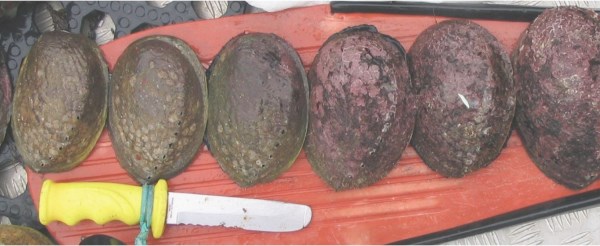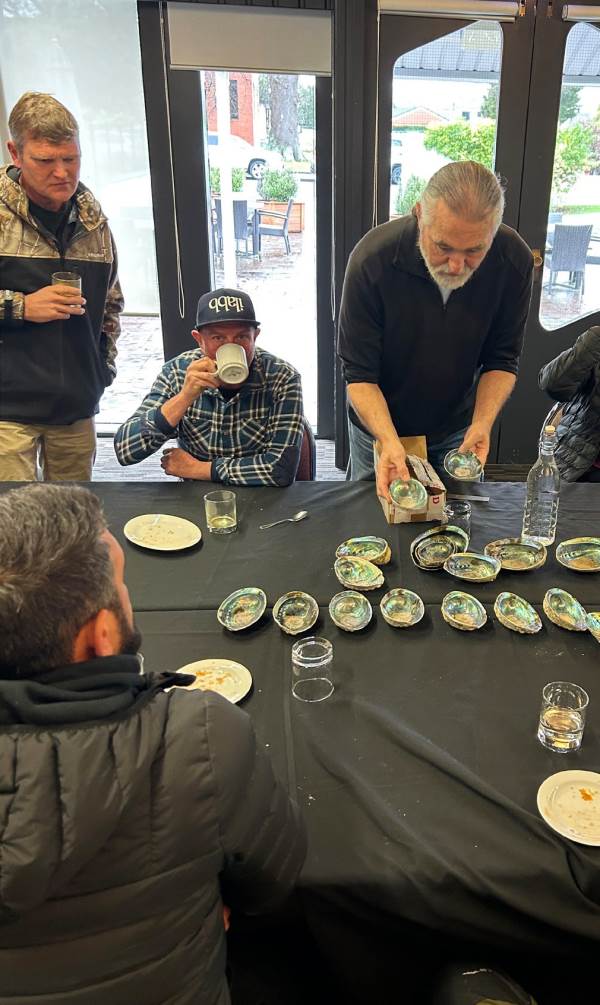
Like most fisheries, pāua fisheries are managed at a high level by two primary management tools: catch limits (i.e., recreational bag limits or commercial catch limits), and minimum legal size (MLS). The purpose of a MLS is to ensure that pāua cannot be harvested until they have reached sexual maturity and remained for sufficient spawning events to sustain population regeneration. A commonly referenced rule for MLS setting in abalone fisheries is the “2-year rule”; that abalone should be allowed to reach maturity, and then grow for two years during which they can breed enough to replace themselves before being caught. The difficulty with this approach is that expensive scientific studies of pāua age, growth and maturity are required to accurately apply the “2-year rule” in any place.
In New Zealand, the MLS is set at 125mm for pāua for almost the whole country based on studies done originally for Kaikōura. However, it is well documented that pāua exhibit great variability in size they mature at and grow to; depending on water temperature and turbulence, habitat and food availability. This means that the single MLS of 125mm is too small in many areas and too large in others.
The commercial fishery has started taking this variability into account by setting variable minimum harvest sizes (MHS) up to 145mm in some areas. While this has had positive effects where it has been implemented, there are still many challenges in establishing the most appropriate size to harvest pāua for each area.

The Pāua Industry Council has recently engaged with Dr. Jeremy Prince, a fisheries scientist and abalone expert from Western Australia who has developed the concept of “Shellology” to address this challenge. This approach uses the appearance of abalone (or pāua) shells to evaluate the effectiveness of the MLS/MHS being used and assess the status of pāua stocks. The underlying premise of the “Shellology” concept is that the maturity and overall reproductive activity of an individual pāua can be deduced by the appearance and shape of the shell rather than solely by its length. Juvenile pāua start their lives in the dark hidden spaces under boulders and in crevices, as they mature, they emerge out onto the surface of reefs to aggregate with other adults to feed on drift weed and to breed.
Characteristic of the fastgrowing juvenile phase of life, the shells of juveniles and sub-adults are flat and oval shaped, and clean of encrusting growth because they have been living in the dark. It is after they emerge into the light and begin maturing that their shells start becoming encrusted, or fouled, usually with a pink coralline algae, their shells also become rounder and domed, higher and wider relative to their length, as they grow faster in weight than in length. These changes in shell shape and appearance occurs relatively consistently across all areas, but at different sizes depending on the growth in each area. Although heavy fishing means that older shells have become rare in many locations.
So, what does this mean for managing pāua fisheries? In areas where the catch is mainly of clean flat oval shells, the MLS is too small to protect a sustainable level of breeding. In the long term, the supply of young pāua is likely to be insufficient to support populations and they will decline. Conversely, where there are lots of heavily encrusted pāua with round domed shells, and pāua with clean flat oval shells are just a small proportion of the population, the combination of the MHS and fishing pressure is conserving a high level of breeding. Those populations are sustainable, and potentially in some cases, with a lower MLS and higher fishing pressure, larger catches could be sustained.
This simple rationale can be used to evaluate the appropriateness of the MHS currently being applied in areas, by observing the appearance of shells being measured as part of the commercial catch lengthfrequency sampling program undertaken by the Pāua Industry Council, as well as by pāua divers themselves going about their business.
Dr. Prince has publications which confirm the idea that the size of emergence corresponds with the onset of sexual maturity (in many species, not just abalone). For pāua, the size of emergence is often significantly larger than the size at maturity determined by traditional methods of gonad assessment that have been consistently relied on for the past three decades of pāua fishery stock assessment and management.
This most likely exacerbates the issues we have with appropriate MLS in our pāua fisheries, especially in southern waters where pāua mature and grow to larger sizes. MLS setting is laden with regulatory and enforcement issues, especially when addressing the scales that are relevant here. However, a general understanding of the characteristics of pāua that suggest they are at an appropriate harvest size is an important first step for both commercial fishermen setting MHS, and for recreational divers deciding which pāua to harvest.
What is the take home message? Leave the clean and flat shelled pāua alone and take the pink rounded ones! Where you can now see that the regulated MLS is too small to sustain for your local patch, work with your neighbours and diving buddies, to implement larger voluntary MLS that conserves the pink rounded pāua so they can at least replace themselves before feeding you.













